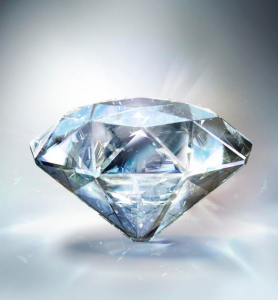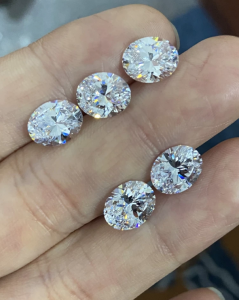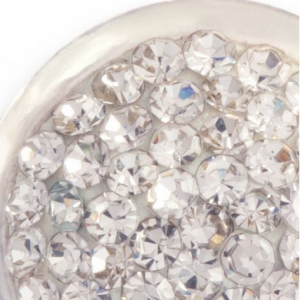by Kim Hartman
Who doesn’t love a little bling? There’s even an old song made famous by Marilyn Monroe: “Diamonds Are a Girl’s Best Friend.” But today there are several different options for “getting your bling on,” as it were. There are diamonds, of course, if you can afford them; but there are also Cubic Zirconia (CV) and Swarovski Crystals. But what’s the difference? How can you know what’s best for you? Keep on reading for a quick guide to help you know your bling.
All about Diamonds
 Diamonds are gems that are naturally occurring—meaning they are formed naturally in the earth. They are made of carbon atoms and are one of the hardest substances on earth. They are extremely expensive, with their price being governed by what’s known as the four Cs: carat, cut, color, and clarity.
Diamonds are gems that are naturally occurring—meaning they are formed naturally in the earth. They are made of carbon atoms and are one of the hardest substances on earth. They are extremely expensive, with their price being governed by what’s known as the four Cs: carat, cut, color, and clarity.
- Carat: This is the actual physical weight of the diamond. The bigger the carat, the more expensive it’s going to be.
- Cut: How a diamond is cut doesn’t refer to the shape, but rather how the diamond’s facets interact with light, along with the proportion of the diamond, and the overall finish (“Understanding Diamond Cut”).
- Color: A truly colorless diamond is very rare; most diamonds will have small defects or impurities, which will give them a tinge of yellow or brown. The more flawless a diamond is, the more expensive it will be (“What’s the Difference”).
- Clarity: Diamonds can have different characteristics–both internally and externally. Internal ones are called inclusions; external ones are called blemishes. Diamonds without inclusions or blemishes are very rare, and therefore more expensive (“4 Cs of Diamonds”).
Diamonds have a high refractive index, which means when light passes through a diamond, the speed of light actually slows down and bends the light. The different colors that make up white light slow at different speeds and separate once they enter the diamond. This separation of the color spectrum is called dispersion (“What’s the Difference”). So what does that mean? When light hits a diamond, you get a beautiful array of colors and sparkle, aka, big bling.
Diamonds are also the April birthstone. If you’d like to read more about the history and meaning of diamonds and the April birthstone, check out our April birthstone blog, “Diamond: The April Birthstone Guide.”
All about Cubic Zirconia (CV)
 Cubic Zirconia have traditionally been the most popular substitute for diamonds because, to the untrained eye, they look identical. CZ is made from zirconium dioxide, which comes closer than any other gem to matching the characteristics of a diamond (“What’s the Difference”).
Cubic Zirconia have traditionally been the most popular substitute for diamonds because, to the untrained eye, they look identical. CZ is made from zirconium dioxide, which comes closer than any other gem to matching the characteristics of a diamond (“What’s the Difference”).
Natural CZ was first discovered in 1899, but it wasn’t until the late 1970s that people started manufacturing CZ to use in jewelry. On first glance, CZ looks just like a diamond, but when you inspect it more closely, there are definitely differences (“What’s the Difference”).
- CZ is heavier than a diamond—it’s actually 1.6 times the weight.
- CZ is not as hard as a diamond. It’s an 8 on the Mohs hardness scale, whereas a diamond is a 10 on the same scale.
- CZ has a refractive index of 2.176 versus a diamond’s 2.417, which means it’s slightly less sparkly. But it has more color spark inside the gem.
- CZ does not have impurities like most diamonds do, which means it’s clear in color. But you can add color to a CZ by adding metal oxides in the production process.
- CZ can’t withstand the same kind of heat that diamonds can, and they are more brittle than diamonds are and more susceptible to scratches and chipping, so it’s important to take good care of them (“What’s the Difference”).
All in all, CZ is a good substitute for diamonds if you want to save money. They’re nearly indistinguishable and much less expensive.
All about Swarovski Crystal
 Unlike its name suggests, Swarovski Crystal isn’t a gemstone or even a crystal! It’s actually a form of glass made at very high temperatures by melting silicon oxide powders with lead to form what’s known as lead crystal (“What’s the Difference”).
Unlike its name suggests, Swarovski Crystal isn’t a gemstone or even a crystal! It’s actually a form of glass made at very high temperatures by melting silicon oxide powders with lead to form what’s known as lead crystal (“What’s the Difference”).
Swarovski has patented the exact process, but we know the crystal has to have at least 32% lead content to increase it’s refraction index to resemble a diamond. In addition, to creating that diamond-like effect, Swarovski must cut crystal glass very precisely. They then use their Swarovski-patented polishing process that gives the crystal its high-quality finish. Often Swarovski will further enhance the crystals by coating them with an AB (Aurora Borealis) coating that gives them a rainbow-like appearance, which simulates dispersion from a diamond (“What’s the Difference”).
Swarovski Crystal has a Mohs hardness rating of 6-7, so it is susceptible to scratches and chips, but it’s also harder than standard glass. The lead in the crystal increases the refraction index of the glass from 1.5 to 1.7, which means the face of the crystal is much more sparkly or blingy (“What’s the Difference”).
When it comes to cost, Swarovski Crystal is definitely the most cost-effective. But Swarovski is also a brand that people identify with high-quality and elegance, which is why so many top fashion brands and jewelers around the world use it, including Style Dots. All of our Couture interchangeable snaps use Swarovski Crystals.
Now when you’re thinking about how you want to show your bling, you have the facts about cost, and what kind of bling you can get for your buck.
At Style Dots, we believe in providing high-quality jewelry at affordable prices, which is why we use crystals, Swarovski Crystals, gemstones, semiprecious stones, and natural stones in our interchangeable snap jewelry.
To learn more, visit StyleDots.com.

